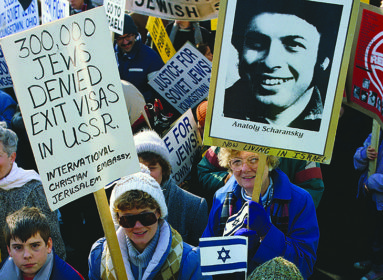
An Israeli tour guide takes visitors “off the beaten path in ancient and modern Israel”
By Cindy Mindell
From a Philistine burial ground to a Late Bronze Age-era Egyptian statue to a 1,500-year-old synagogue mosaic floor to a hoard of Hasmonean coins, reports of major archeological discoveries seem to emanate from Israel nearly every month. While experts may disagree on how to interpret archeological remains, many finds seem to corroborate or illuminate the sites and characters mentioned in the Torah, bringing Bible stories to life through scientific evidence and tangible artifacts.
In a new guidebook, Israeli tour guide Julie Baretz animates 21 of the sites described in the Hebrew Bible, tracing the arc of Jewish history from the Israelites’ arrival in the land of Israel after the exodus from Egypt, and chronicling the six centuries until the return of the Jewish exiles from Babylon to their homeland. At each stop, The Bible on Location: Off the Beaten Path in Ancient and Modern Israel (The Jewish Publication Society, 2015) illuminates places, personalities, and events through historical context, the actual biblical text, and the author’s own commentary. Baretz’s narratives draw on history, archaeology, academic scholarship, and rabbinic literature for interpretations that enhance the meaning of the biblical events.
Baretz will discuss her book on Wednesday, Aug. 10 at Congregation Beth El-Keser Israel in New Haven.
A native of Valley Cottage, N.Y., Baretz moved to Israel in 1985. She completed the Israel Government Tour Guides training program and received her license from the Ministry of Tourism in 1987. Since then, she has guided thousands of Jewish and Christian visitors around the country. She earned a master’s degree in Creative Writing from Bar Ilan University in 2004 and has written numerous articles on tourist sites in Israel for online publications. She appeared as a guest expert on the Travel Channel series, Secret Worlds with Michael Arbuthnot for the episode, “Mystery of the Templars,” which aired on July 3, 2010.
She spoke with the Ledger about the inspiration behind her book and the timelessness of the sites and stories that she chose to include.
Jewish Ledger (JL): Why did you decide to write The Bible on Location?
Julie Baretz (JB): I’ve been a tour guide for 29 years and I split my time pretty much 50/50 between Jewish groups and Christian groups. Christian groups are bread and butter for Jewish tour guides because they’re over half of the tourism in Israel. I have worked with Evangelicals for many years and what I discovered right off the back is that they know their Bible really well – not just their New Testament but their Old Testament. I was embarrassed because I didn’t know it well at all. I had to do some quick self-educating at the beginning and eventually I learned the passages that I needed to know for the places that we visit in Israel with Christians.
But what I eventually discovered was that it wasn’t enough to just read the texts on site, which is a wonderful thing to do and which everybody loves. Because I had never studied the stories, I had nothing of substance to say about them. So I decided to get myself a rabbi and to do an independent, in-depth study of the stories that I was dealing with on a regular basis, which are basically the post-Torah books: Joshua, Judges, 1 and 2 Samuel,
1 and 2 Kings, Ruth, Ezra, and Nehemiah. Over a period of two years, we studied these stories very closely and very intensely and I was so excited by what I was learning and so sorry that I had missed all this great stuff for all these years. I think I had a pretty good Jewish education growing up – I was raised in a Conservative synagogue and went to Camp Ramah and Young Judaea – so I thought that if I had missed it, then a lot of other people had as well.
JL: It sounds as if the Bible on Location is more than just a tour book.
JB: The book includes 21 sites all over Israel where Bible stories took place. The idea of the book is to bring you to the site, to enable you to read the texts on site, and to discuss them on the site to raise ideas to think about regarding the themes and the universality and the timelessness of the book. My mission in writing this book is to make these texts accessible because most of us never read them. Who read Second Kings unless you went to Jewish day school? Or Joshua or Judges? Judges is an amazing book.
There are just incredible characters and so many social and moral and ethical and religious dilemmas that the characters face that could be anybody today.
A propos, there’s been an ongoing case in Israel of a very high-up officer in the Israeli army who’s being accused of rape and sexual harassment. His name is Ofek Buchris and when they first announced the case, they wouldn’t say his name and all they would say is that he’s a gibor Yisrael, a national hero. The parallels, immediately, were to King David and the whole Bathsheba affair.
Here’s this incredibly talented Golden Boy who has everything and he throws it all out the window for a babe. So the biblical stories are reverberating all the way into the future here. That’s one of the things that struck me so much about these stories: how relevant they are to our lives today, and I wanted to share that with people.
JL: What are the differences between Christian and Jewish readings of the Bible and the land?
JB: I would say that the Christians read the Bible and they treat the biblical figures with great reverence. When we Jews read the same stories, we are far more critical.
Our inclination is to deconstruct the story in order to get to the real meaning that we hope to find there, and in the process of that deconstruction we put the characters under a very harsh microscope. That’s a big difference. It’s not that Christians are not willing to see the flaws of these characters, but the fact that they’re biblical characters gives them a certain halo despite their flaws.
In our Jewish tradition, we’re not as kind to them. One of the literatures that I mined for my research in writing my commentary on these stories was rabbinic literature. I basically took from the archeology and the historians and academic biblical critics. I really wanted my commentary to have a scientific basis to it but there’s a lot of great stuff in the rabbinic literature as well and the rabbis have some very harsh things to say about those biblical characters – really, no mercy whatsoever, and that’s more typical of our tradition in reading these texts than it is the Christian tradition.
JL: UNESCO’s executive committee recently passed a resolution denying the Jewish claim to the Temple Mount in Jerusalem — referring to it as a site that is holy only for Muslims. What is your take on that?
JB: It is laughable to state that there’s no Jewish connection to the Temple Mount because the Christian and the Muslim connections are all based in the Jewish connection, which defined that spot a very, very long time ago – as a matter of fact, with King David – as the most sacred space on earth for the Jewish people. According to the Jewish tradition, the Temple Mount is the place where we believe that the spirit of God resides on earth. That’s why Solomon built the Temple there and that’s why it’s holy to the Christians because Herod’s temple was there and Jesus visited in the Temple. And that’s why it’s holy to the Muslims because when the Muslims conquered Jerusalem, the Muslim commander said, “This spot is holy because this is where Solomon’s Temple was.”
The Palestinians have transformed the Temple Mount into a very ugly political issue. They have completely politicized a sacred space. At some point, Yasser Arafat decided that there was no Jewish connection to the Temple Mount, there was nobody there before the Muslims, and so be it. But what’s absolutely ridiculous is that we have copies of the tourist literature that was published by the Waqf – the Muslim Religious Trust Organization – in the early 20th century, that states very specifically: “This site is holy to us because this is where Solomon’s Temple was.” It’s also of course holy because, in the Islamic tradition, that’s where they believe that Mohammad rose up to heaven and had a conference with God and came back down again. But the original sanctity goes back to Solomon and they say it themselves.
So for a committee of UNESCO – which is obviously so tainted with politics – to come along and decide that there’s no Jewish connection to the Temple Mount, I don’t know whether to laugh or to cry when I hear something like that.
JL: How do “ancient” and “modern” work in the title of your book?
JB: When we’re talking about modern Israel, we’re talking about it on two levels. First of all, you have to drive and walk through modern Israel to get to the ancient sites; they’re embedded within one another. Some of the sites are smack in the middle of residential areas today. For example, the Broad Wall is right in the middle of the Jewish Quarter of the Old City of Jerusalem.
But in addition to modern Israel being geographic, because these stories resonate so strongly in our reality, when we read biblical stories, it’s in a way like visiting modern Israel because there are so many parallels between the biblical characters and politicians in Israel today. This is one of the things that really struck me during my studies: we’d be reading a story and all these associations would come up with modern Israeli figures. For example, the story of Amnon, who rapes his sister Tamar and then sends her away – we were reading not far from the time when former Israeli president Moshe Katsav was being put on trial for rape of his subordinates. There were so many similarities between these men who think that they’ve done nothing wrong, they can do whatever they want. They can rape a woman if they want and who’s going to say anything about it? From that sense, these stories are in many ways about modern Israel as well.
JL: Do you have any favorite sites among those you include in your book?
JB: When you study the stories that deeply, they become like your children; they all become my favorites. I would say that the David and Bathsheba story in the City of David is one that has resonated particularly strongly.
I tell the story again and again so many times and everyone who hears it is enthralled by it because it epitomizes that famous saying, “Power corrupts and absolute power corrupts absolutely.” If I tell that story with a group and we sit around and talk about modern men who have found themselves in that position – whether they’re politicians or leaders of faith communities or businessmen or sports personalities – it reminds us of what happened to David. It’s a very disturbing story but a very searing lesson and it reverberates very strongly and loudly in our day.
Julie Baretz will discuss her book, The Bible on Location: Off the Beaten Path in Ancient and Modern Israel, on Wednesday, August 10, 7-8:30 p.m., at Congregation Beth El-Keser Israel, 85 Harrison St., New Haven. For information: beki.org / (203) 389-2108.








 Southern New England Jewish Ledger
Southern New England Jewish Ledger















